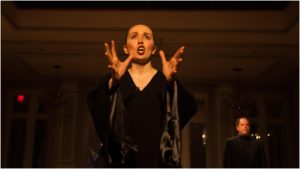
Bohemian National Hall 2018 – Master-Pieces: Petr Kotik Opera Is An Intense & Thought-Provoking Experience
By Jennifer PyronThroughout his career, Petr Kotik has explored musical boundaries as a performer and composer. He studied flute at the Conservatory and Music Academy in Prague, and composition at the Music Academy in Vienna. In the 1970’s, Kotik performed experimental music and established himself as a musician full of new ideas. And now, in 2018, Kotik has redefined his path to composing, especially in his 2014-2015 chamber opera “Master-Pieces.”
Focused on the importance of text and narration, Kotik’s opera highlighted Gertrude Stein’s 1936 lecture “What Are Master-Pieces And Why Are There So Few of Them,” with interspersed text from Stein’s “The Wars I Have Seen”, written in 1943-1944. The Bohemian Theater housed this production last weekend, and audience members witnessed the U.S. premiere of the fully staged version directed by Jirí Nekvasil.
Kotik’s preliminary ideas for creating “Master-Pieces” came together organically when he was commissioned to compose an opera for the festival New Opera Days Ostrava (NODO) 2014 festival. He started his work by composing a piece for a soprano and violin. During this time, he was transcribing Stein’s lecture, and thought it best to combine the two. Michael Raub also contributed to the creation and in 2015, the chamber opera premiered in the biennial festival Ostrava Days.
At the Bohemian Theater, the audience was seated on stage, facing a dimly lit hall. A single spotlight illuminated violinist Pauline Kim Harris as she started to play. Every listener was silent and fully engaged. New spotlights captured other musicians of the S.E.M. Ensemble as they entered, until eventually the chandeliers brightened and revealed soprano Christina Kay. Kotik conducted from the side of the theater’s main floor and managed to control performers all over the room. Three narrators, Debra Kay Anderson, James Falzone, and Kerry Wolff were heard from the balcony, as they presented text from Stein’s “The Wars I Have Seen.” Mixing the narration with Kay’s singing created a multi-dimensional body of work that allowed the listener to be fully immersed in Gertrude Stein’s thoughts. There were tangents that felt all over the place when tenor Steven Wilson, baritone Jose Pietri-Coimbre and bass Nicholas Hay joined Kay in singing. Kotik stated that “[t]he work’s energy originates from the very question asked by Stein in her lecture, as she continuously veers away from the subject to contemplate and instigate issues of the creative process and the relationship between the artist and the artist’s work. The words – sometimes sung and sometimes spoken – strive to retain the poetry of Stein’s language while opening various layers of meaning.”
“Stein’s ‘Master-Pieces’ is a meditation on the nature of the creative process, and on works that we identify as masterpieces,” Kotik stated. The music that he composed to showcase all of her text was bold and dramatic. There was never a moment of rest between the entrances of the performers and choreographed movements continuously happening.
“I talk a lot
I like to talk and I talk even more than that
I may say, I talk most of the time, and I listen a fair amount too
The essence of being a genius is to be able to talk and listen
To listen while talking and talk while listening
But,
And this is very important
Very important indeed
Talking has nothing to do with creation”
Stein’s text made for a perfect libretto because she understood the full meaning of creation and her meditation explored all levels of understanding. She pivoted from seriousness to ease and back again in her lecture, which Kotik musically played into through every instrument. For example, the soprano transitioned from singing to speaking often and eventually blended the two. Christina Kay’s voice was perfect for the portrayal of Stein’s text. Kay infused an underlying anxiety that illuminated the intensity of delivery surrounding the lecture. One could translate Kotik’s overall design for this chamber opera best, when comparing the libretto to the music. By investigating the two apart, one could see the full spectrum of meaning behind the combination and each instrument’s role. Especially when the most important part of Stein’s lecture is followed by a violin solo that gave the audience time to digest. This was a rare moment and it highlighted the core of her entire lecture.
“Talking is human; talking is human nature
Human nature has nothing to do with creating master-pieces
Master-piece has nothing to do with human nature of with identity, nothing to do with identity or human nature,
It has to do with the human mind and entity
With entity and human mind
A work of art is a thing in itself
A thing in itself
And not in relation to anything
No relation
The moment it is in relation, it is common knowledge”
At the close of the opera, Christina Kay and the three men were standing directly in front of the seated audience, which created a lot of tension. Listeners watched as she then turned around and silently walked to the back of the hall in her black gown. A single line of intense light seared into her, as she dramatically paused in the back. One could feel the weight of Stein’s words and relate strongly to the passion behind her text and Kotik’s music combined. Overall, this was a very thought-provoking and intense experience.


